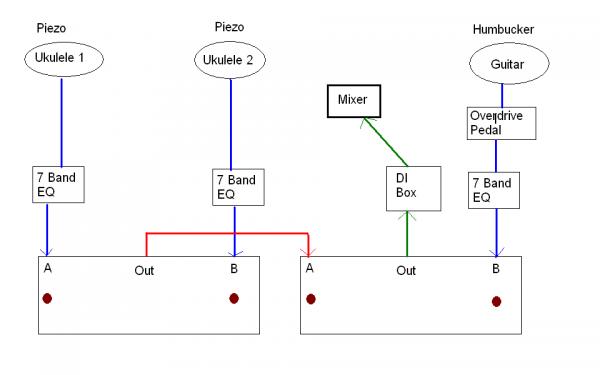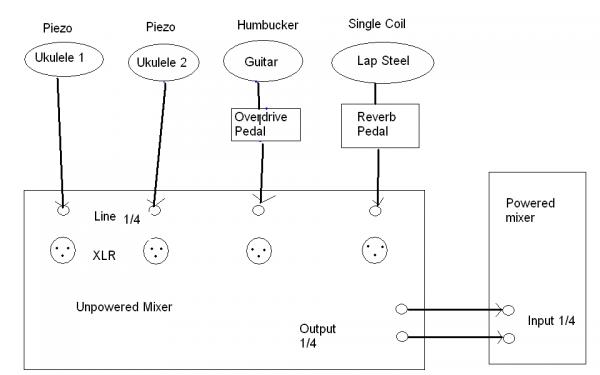I have a small band in which I play 2 different Ukuleles with externally mounted Dimario piezo-electric pickups, and an archtop acoustic with a suspended humbucker pickup.
Each of the ukes is plugged into it’s own 7 band EQ pedal. The guitar is plugged in to an overdrive pedal then it’s own 7 band EQ.
I then plug each of the EQs in to two AB switches daisy chained together that feed a single DI box that feeds one channel on the mixer (Carvin 880).
I attached a diagram1.
Once I set the EQ and volume on each instrument I can press the proper switch on the AB switches and pick up the corresponding instrument and play and it sounds great.
The drawback is that is an awful lot of stuff on the floor.
Now I have just added a lap steel to the act, it has a single coil pickup. I was thinking about buying a small 4 channel mixer and mounting it on a stand where I can just control the instrument I am using with the channel output or a mute switch (some small mixers have them).
But I have gotten confused about the role of the DI box. In my current configuration I switch to the DI. Do I really need a DI for each channel if I use a mixer? Can I just plug the instruments into the line inputs on the small mixer. See Diagram2
I have also found a 4 channel DI/mixer to buy but it doesn't have any EQs So I would have to keep the EQ Pedals. Kind of defeats the purpose of using a small mixer.
Does anyone have some advice?
Tags
Comments
Thank you for taking the time to reply. It was very helpful and
Thank you for taking the time to reply. It was very helpful and much appreciated. If I have a pedal like a BOSS distortion or a Reverb connected between the guitar and the Mixer should I still use a DI before the mixer? If I wanted to measure the resistance of a pickup is it as simple as placing the leads from a multimeter on the pickup leads. Again, Thank You for taking the time to address such basic questions.
The output of a pedal can usually be taken into a mixer's line i
The output of a pedal can usually be taken into a mixer's line input, but you have to be careful what happens in the pedal's "bypasss" position. If this disconnects the internal electronics and simply connects the output to the input, you still need the DI box.
You will not get meaningful results from multimeter measurements on pickup leads. A wound pickup will give you a few Ohms reading, and a piezo will likely as not read open circuit.
The output of a pedal can usually be taken into a mixer's line i
The output of a pedal can usually be taken into a mixer's line input, but you have to be careful what happens in the pedal's "bypasss" position. If this disconnects the internal electronics and simply connects the output to the input, you still need the DI box.
You will not get meaningful results from multimeter measurements on pickup leads. A wound pickup will give you a few Ohms reading, and a piezo will likely as not read open circuit.




The DI box achieves two things: it presents a high impedance at
The DI box achieves two things: it presents a high impedance at the transducer input, and drives the low-impedance cable to the microphone input of the PA mixer. The high-impedance input is very important for piezo transducers, which will not sound good if run into an impedance of less than about 100K Ohms. Most line inputs of mixers have impedances in the range of 10 - 20 KOhm, and are thus not suitable for direct connection of piezo transducers. If your archtop guitar and lap steel have built-in pre-amps (usually identifiable by needing a battery), these would probably be happy going into the line input of a mixer, but I'm assuming that this is not the case.
Having a local mixer with individual EQs and level controls per channel is the traditional solution to the multi-instrumentalist requirement of performer control of the sound, and it also avoids the problem of insufficient channels in the main PA mixer to run individual DIs. You would need either to look for a mixer with high-impedance inputs or use separate DI boxes for each instrument connected to the XLR mic inputs of a standard mixer. The other consideration is sonic quality; going for a cheap mixer that has all the right paper specifications may compromise your instrumental sound by not having the headroom at the inputs or the tonal quality in the EQ section that you would like.
I don't know of any small-format mixers that have more than two DI inputs, so my preference would be to go for a good small standard mixer such as the Mackie ProFX8 that has a single DI input, and use external DI boxes to the XLR mic inputs for the other channels. You need feed only one of the local mixer's output channels to a line input on the main PA mixer, unless you make use of the stereo effects in your local mixer and want the full effect to be heard in the PA. In this case, you would need to send both L and R outputs to a stereo input or two panned mono channels in the PA mixer.